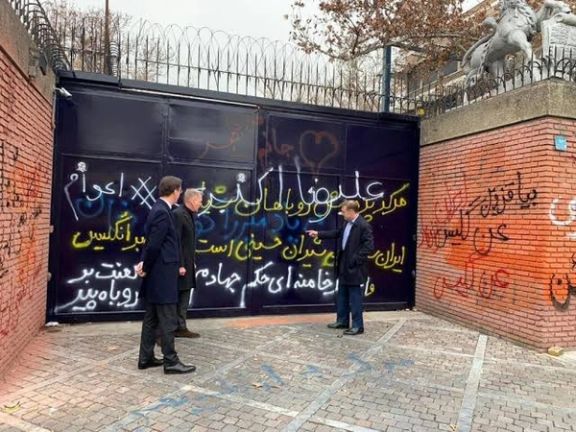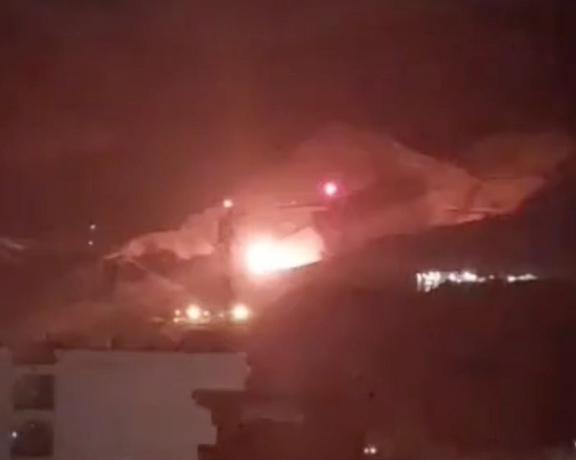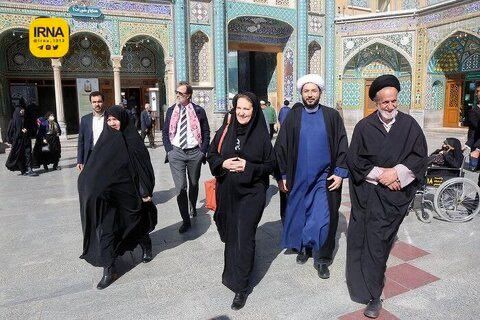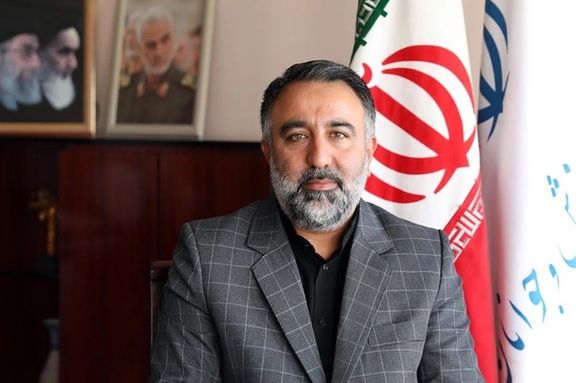Iran’s Rial Hits Another Historic Low Against Major Currencies

Iran’s currency rial kept hitting new lows on Friday and broke another resistance point, dropping to 540,000 to the US dollar and 570,000 to the euro.

Iran’s currency rial kept hitting new lows on Friday and broke another resistance point, dropping to 540,000 to the US dollar and 570,000 to the euro.
The new record low was recorded in unofficial trading on Friday, which is weekend in Iran and many people are waiting to see the trade rate Saturday morning.
Last Monday, the country experienced a shock when the rial fell to more than 500,000 against the US dollar from 460,000 only a week earlier and 300,000 in late August.
The cash-strapped regime is trying all the tricks to stop the devaluation of its currency but to no avail as the inflation rate is rising and people are desperate as they cannot afford basic foods.
If the rapid slide continues in the coming days, it will make daily living almost impossible for ordinary Iranians, who already cannot afford higher-priced meat, dairy and other necessities.
An informed Iraqi source told Iran International on Thursday that the recent trip by Iran’s Foreign Minister Hossein Amir-Abdollahian to Baghdad was focused on ways to retain the flow of foreign currency from the neighboring country.
Earlier in the month, Iran International obtained information that the Islamic Republic is suffering from heavy financial losses because a huge amount of its money is blocked in Iraq because of US sanctions.
Washington has imposed new restrictions on dollar transfers to Iraq as the Arab country’s banking officials believe there is widespread money laundering sending funds to Iran and Syria.

Iran is reportedly preparing to close the British embassy in Tehran as tensions simmer over a plot to kill journalists in UK, and London’s rebuke of crackdown on dissent.
In an exclusive report on Friday, the Jewish Chronicle claimed that Iranian officials revealed “the possible step” at a secret meeting with ambassadors from Oman, Kuwait, and the United Arab Emirates on Tuesday.
The media outlet cited one of those present at the meeting as saying that the Islamic Republic plans to announce a range of new sanctions to hit back at Britain, which has imposed several rounds of sanctions since the current wave of protests began in the country sparked by the death in custody of 22-year-old Mahsa Amini in September.
On Wednesday, February 22, Iran’s Revolutionary Guard took credit for the relocation of Iran International studiosfrom the UK to the US following terror threats, calling it a victory for the Islamic Republic.
The British embassy in Tehran has been a regular flashpoint in recent years. In December 2022, its walls were defaced by the Basij paramilitary militia, one of the forces operating under the IRGC, with slogans labelling it a “terrorist center”.
According to UK Security Minister Tom Tugendhat, Iran is also hiring organized criminal gangs to spy on Britain’s Jews in preparation for a potential assassination campaign against prominent community members. Earlier in the month, Jewish journalist Catherine Perez-Shakdam -- who infiltrated the regime and met Supreme Leader Ali Khamenei -- told the JC the plans were designed to ensure “the diaspora would have a very nasty surprise” in the event of an Israeli attack on Iran’s nuclear facilities.

After long airing forced televised ‘confessions’ of dissidents, Iran's regime is increasingly coercing individuals to post dictated statements on social media.
Last week a video of a woman unveiling at an official event in Tehran went viral on social media. On Wednesday, the same woman posted a video of herself apologizing for her “rash” behavior.
Zeynab Kazempour, an engineer, removed her headscarf during the annual assembly of Tehran Construction Engineering Organization (union) after her application to run as a candidate for the board was turned down, presumably on the grounds that she did not abid by the compulsory hijab rules.
In the video, Kazempour is making a short statement on the stage of packed auditorium -- with her headscarf around her neck instead of her head -- about being excluded from the union’s elections. She then throws the headscarf on the floor while storming out as many of her male and female colleagues, both on the stage and among the audience, cheer and applaud her.
“I reacted momentarily, without premeditation … I regret [my reaction] and apologize to the public,” she says in the video.
“Releasing this type of videos has long precedence,” Dadban, a team of volunteers who provide legal advice to activists and protest victims, tweeted Wednesday, adding that security bodies are now forcing dissidents to make coerced statements in front of their own cameras instead of the cameras of the security forces for television.
Iran's state-run television has aired the so-called “confessions” or forced statements of dissidents, activists, individuals accused of terrorism, economic sabotage, blasphemy, and even family members of government violence victims since the very early days of the Islamic revolution to justify prosecution, or execution, of individuals and to discredit opposition groups.
In October, statements very likely to have been acquired under duress from dissident rapper Toomaj Salehi were aired by the state television.

Many Iranians also believe that since his arrest in September, and being released on bail in October, another popular artist Shervin Hajipour whose song “Baraye Azadi” (For Freedom) has become an anthem for Iranian protesters has been under pressure to post “dictated” content on Instagram.
Shervin whose song won this year’s Grammy Awards’ “Best Song for Social Change”, a new category, said in a post on Instagram after his release from prison that he was sorry that his song was being used by dissident political groups outside Iran. After winning the award he also said in a post he regretted that his award was presented, in absentia, by the US First Lady Jill Biden.
The once quite effective televised “confessions” have largely lost their clout in the Iranian society where many repudiate them as mere propaganda. As a counter-measure, many now even refuse to share or like social media posts that they think have been dictated to the author by security forces or extracted under duress in prison and even block those who circulate such videos on their accounts.
“Such [coerced] confessions may have worked in the early days of the revolution but fortunately they have lost their [desired] impact now due to being repeatedly used for all sorts of things. These have even made the incompetent security organs the butt of jokes,” Maziar (Mazyar) Ebrahimi, a businessman who was tortured to ‘confess’ that he had been spying for Israel and was involved in the assassination of Iranian nuclear scientists in 2012 tweeted about the airing of anti-compulsory hijab activist Sepideh Rashno’s forced statements in August.

Residents near Karaj, west of Tehran, published videos of anti- aircraft fire Thursday night, which the government media described as military drills by the IRGC.
One of these videos showing anti-aircraft tracer rounds soaring into the sky an explosion can also be seen on the ground, but no further information is available. There was no prior public notification of planned military exercises.
Some residents reported on social media that first a series of explosions were heard and then anti-aircraft guns began firing into the air.
Fars news agency affiliated with the Revolutionary Guard reported Thursday night that the sound of guns firing and explosions were coming from drills by IRGC’s paramilitary Basij forces in Shahid Motahari military base near Karaj, about 30 km west of the capital.
Iran has been the scene of several suspected air attacks and sabotage operations since July 2020, largely ascribed to Israel. Any sound of aircraft or explosions usually jolts the population and leads to speculations of another attack taking place.
Serious acts of sabotage targeted Iran’s nuclear installations in 2020 and 2021 and several unexplained explosions occurred at military and naval bases.
The latest incident occurred on January 28 around midnight when a military manufacturing center in the city of Esfahan was attacked by drones.
The Wall Street Journal quoting unnamed US officials reported that the attack was carried out by Israel.

The Swiss Foreign Ministry defended the decision by its ambassador in Tehran, Nadine Olivier Lozano to wear the full body veil, the chador, on a visit to Qom yesterday (Wed) following global outrage claiming the undermined five months of protests against the compulsory hijab.
Léa Zürcher, the Foreign Ministry spokesperson, claimed the ambassador had visited the holy city of Qom to attend an interfaith event at an unnamed university. Zurcher claimed “a short visit to an important religious site took place” and “the applicable dress protocol for women was followed”.
However, the black chador which covers the whole body, is not required of visiting female foreign dignitaries who can simply wear a long headscarf at the site.
Social media was flooded with condemnation, including leading political voices around the world who said the move flew in the face of global support for the protests which were sparked by the death in custody of Mahsa Amini, arrested by the morality police for the inappropriate use of her hijab. The nationwide protests have since seen hundreds killed and thousands more arrested since September in brutal crackdowns by security forces.
Hillel Neuer, Executive Director at Human Rights Watch, tweeted: "Meet Nadine Olivieri Lozano, Swiss Ambassador to Iran and star of the murderous regime's propaganda. While women in Iran are being beaten, blinded, tortured, raped and killed for daring to protest the compulsory hijab laws, she is complicit in her head-to-toe chador and hijab."
The Swiss embassy, responding to the global outrage, denied the move undermined the human rights aspect of the protests which deny women the basic right to choose how to dress.
“Switzerland repeatedly and clearly takes a stand on human rights violations in Iran,” Zurcher added. “In recent months, it has repeatedly and unequivocally condemned the use of violence against the demonstrators at various levels and also called on the Iranian authorities to choose the path of de-escalation and to seek dialogue with the demonstrators.”
During the visit, Lozano is seen with several clerics, gifted a religious book from one of the shrine’s caretakers at Iran's second most holy city, after Mashhad, home to the biggest and most prestigious of Iran's Shiite seminaries. Qom has been at the center of controversy for years, its institutions being disproportionately funded, not least, while the country is suffering from a bitter economic crisis.
Institutions such as the Al-Mustafa International University attract foreign students from countries across China, Africa and Latin America, teaching them the foundations of Shia Islam to take back to their countries, at the expense of the Iranian people, while millions of Iranians cannot afford to eat or heat their homes during the bitter winter months.
Masih Alinejad, a leading Iranian activist in exile, whose life was recently threatened by the country's security forces, called the ambassador’s decision “shameful” and a “betrayal to Iranian women”.
She tweeted: “While teenagers & women are getting beaten, jailed & killed for saying NO to forced hijab, NO to gender apartheid regime, Swiss ambassador in Iran obeyed forced hijab …Switzerland must respond why they took side with our killers.”

The helicopter carrying the minister of sports, Hamid Sajjadi, has crashed in southern Iran while landing in the sports complex of Baft city.
Hospital sources reported that the sports minister's adviser, who was injured in the accident, has lost his life. The adviser who died was Esmail Ahmadi, who was the IRGC liaison in the ministry and was in charge of putting pressure on athletes who removed hijab during national and international competitions.
Media in n Tehran say that the minister has cerebral hemorrhage, although the government’s official news website IRNA has not reported about his injury.
Local media report that at least four passengers were also injured and transferred to medical centers.
In an interview with IRNA, an eyewitness said he saw several people taken to medical centers after the chopper lost control while landing.
A photo of the accident shows a part of the copter is detached.
Alireza Poursalman, the head of Iran’s Fencing Federation, was accompanying Sajjadi on the trip. Some other local officials along with a group of journalists had gone to Baft with the minister.
IRNA cited Kerman’s governor, Mohammad-Mehdi Fadakar, as saying that the cause of the crash is under investigation.
In January, the European Union imposed sanctions on Sajjadi over Tehran’s crackdown on anti-regime protests.
The sanctions included a travel ban and asset freeze on the minister, who the EU accused of pressuring Iran’s athletes into silence.
Iran International obtained some documents in December 2022 showing that the security of the Ministry of Sports, in a confidential letter, asked the federations and all provincial offices to prevent athletes from showing support for nationwide protests following the death of Mahsa Amini.